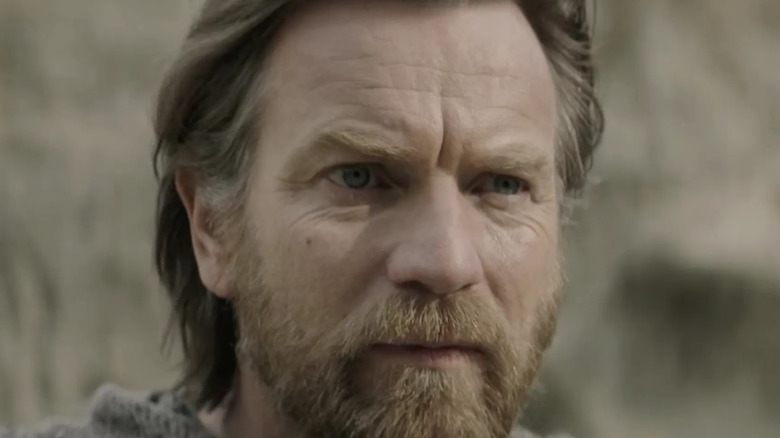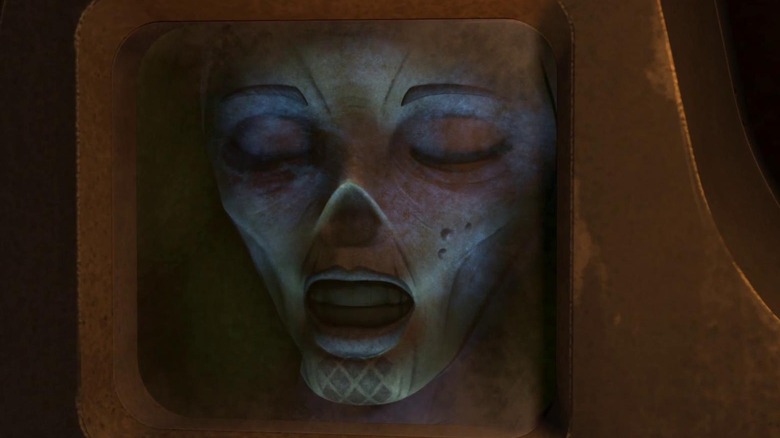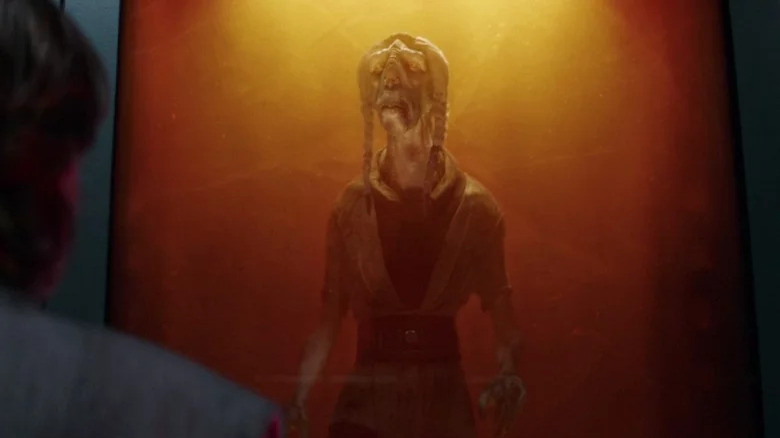That Creepy Tomb Scene In Obi-Wan Kenobi Explained
There's a horror in the most recent "Part IV" of "Obi-Wan Kenobi" that disquiets its eponymous Jedi. In an effort to rescue Princess Leia from the Third Sister's interrogative grip in the Fortress Inquisitorius on the water-based moon Nur, Obi-Wan Kenobi slinks down a corridor. Down the hall is a macabre museum of mummified Jedi, encased in something like amber resin. One possibly familiar face fans might identify is the Cosian Jedi Master Tera Sinube (who assisted Ahsoka Tano in retrieving a stolen lightsaber in a Kurosawa-inspired "The Clone Wars" episode "Lightsaber Lost"). A few unknown Jedi Knights are included. Most chillingly, Kenobi freezes when he spies an encased Youngling (credited as both Jonathan and Oliver Ho, likely child actors who took turns as one character due to child labor laws, and also were among the Younglings that popped up in the "Part I").
With utter dread, Kenobi mutters, "It's a tomb." It's a stark contrast to the last episode where Obi-Wan's expression glimmers with hope when he discovers that there are Jedi survivors, who carve hopeful quotes for survivors like him.
Why keep Jedi corpses?
Obviously, like a prideful hunter who mounts an elk's or moose's head above their fireplace, Inquisitors would love to collect those demented trophies of their kills (much like the Youngling helmets and lightsabers that were spied in the background early in the series).
But the storage of preserved bodies has also served a nefarious purpose for the Inquisitors. In season 1 of the "Star Wars: Rebels" cartoon, Order 66 Jedi survivor Kanan Jarrus and his padawan Ezra Bridger learn from a report where Jedi Master Luminara Unduli is being held prisoner. Wanting to rescue a Jedi and provide Bridger a proper Jedi teacher, Kanan is naturally determined to liberate her.
But it's a trap. Once they make it to the prison cell, they're confused by a hologram projection of her final moments. Then they witness her holo projection walk straight into an upright coffin with a viewing window, revealing the actual frozen corpse of Unduli. The shock of that revelation also punctuates the debut of the Grand Inquisitor, who menacingly shares that "[Luminara's] bones continued to serve the Empire."
Throughout that rescue mission, Kanan was relying on his Force-sensitivity to track and feel the Jedi Master's presence. He does sense her presence yet admits that it's "clouded." This is what makes the Inquisitor's bait so effective in luring an inexperienced Jedi like Kanan Jarrus. A Jedi doesn't necessarily have to be alive for another Jedi to sense them. It just takes some old-fashioned mortuary storage to throw off their senses.
Unrevealed experiments
This is where things get speculative. The amber resin evokes the "Jurassic Park" cloning technique where dinosaur blood is extracted from amber-encased insects. Considering the Star Warsy cloning science that exists in its galaxy, stored blood full of Midi-chlorians from various species would be seen as experimental assets to the Empire — see also Moff Gideon's fixation on Grogu's blood in "The Mandalorian" and the "The Bad Batch" finale hinting that we will learn more about the Empire's cloning experiments. While frequent fan theories often toss around the engineering of Snoke of the Sequel Trilogy, there are likely other Empire experiments in the queue. Whether Jedi blood comes into play soon in "Obi-Wan Kenobi" or other Star Wars media is yet to be seen.
But the prime takeaway of the tomb is this: How long can Jedi survivors across the galaxy keep themselves safe from the fate of becoming a frozen body in the Inquisitors' mummy museum? Those corpses are a warning to Obi-Wan Kenobi, a bereaved Jedi, just how easily evil can co-opt the hope of fellowship into symbols of desolation.


